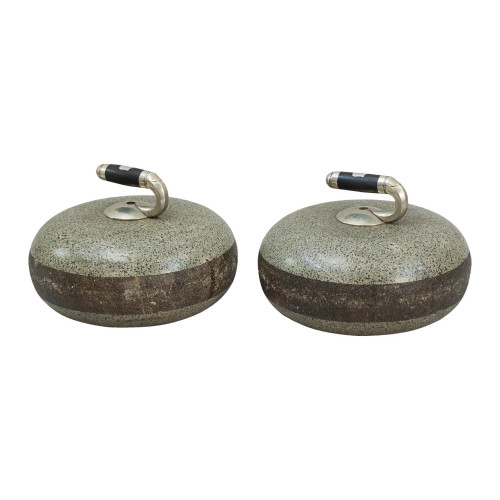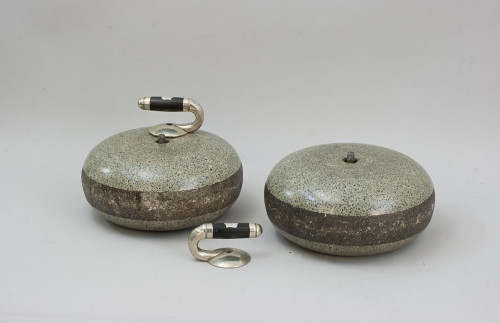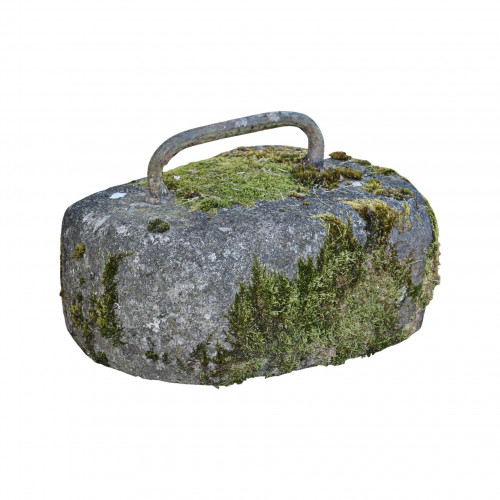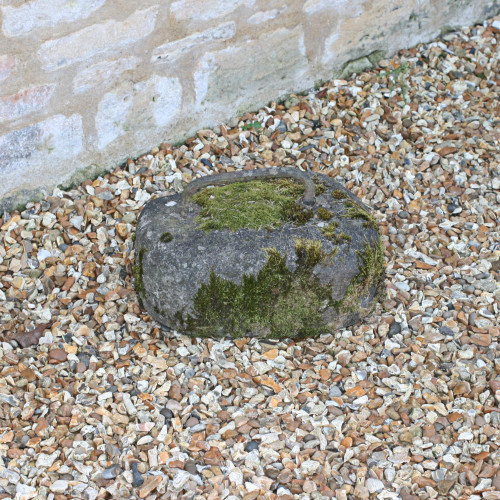- Home
- Alpine, Wintersport & Mountaineering
- General
- Pair Of Curling Stones, Ailsa Craig
Pair Of Curling Stones, Ailsa Craig
Pair Of Curling Stones, Ailsa Craig
30276
Pair Of Double - Soled Granite Curling Stones.
A 20th century pair of traditional double - soled, machine - made grey granite curling stones. The stones have a dip in the top and bottom, this is to locate the one-piece cast plated brass goose-neck handle with turned grip, and allows for the stone to be used on either side. The handles have decorative leather washers, one is stamped with a '5', the other 'L.C.C'. A very good decorative pair of stones and very good as door stops. Curling stones are traditionally made of granite, a material found all over the world. However, for the sport of curling, nothing can replace the unique properties of the granite hewn from a quarry on the island of Ailsa Craig off of Scotland's Ayrshire Coast. The stones are the former property of Partick Curling Club.
The Ailsa Craig granite is some of the hardest and purest found in the world and maintains its shape despite the moist, wet conditions of the ice surface curling is played on.
The size shown is for each stone and the height of the stone is 14 cm without the handle, circumference 87 cm.
The exact origins of curling are unclear but it is known to have a long history in Scotland, and it was through Scottish immigrants that the game of curling spread to other parts of the world. Early curling was an out door sport that was played on frozen lochs and ponds. Because of the unpredictable weather artificial curling rinks were being made to make a little frost go a long way. Concrete rinks were flooded with small amounts of water so they would freeze solid after a night of frost, thus having a rink to play on when the frozen lochs or ponds were unsafe. The first Curling Clubs were formed in Scotland as were the first rules to standardize curling and its equipment. The Grand Caledonian Curling Club was founded in Edinburgh in 1838, they formally adopted these new rules and became the sport's governing body. They heavily supported the use of round granite stones and rather than eight players each throwing a single stone it changed to a team of four players using two matched stones each. Four years later, in 1843, Her Majesty Queen Victoria so fascinated by the game demonstrated on the polished floor of the ballroom of Scone Palace near Perth she granted the Club the title of Royal Caledonian Curling Club. Curling was firmly established in Canada by the Scots with The Royal Montreal Curling Club being established in 1807, the oldest sports club still active in North America.
Dimensions:
1950-1999
C. 1900
Granite
Scotland
Great condition.
Thank you for your enquiry.
We will get back to you soon.
Please create wishlist to add this item to
RELATED ITEMS




































